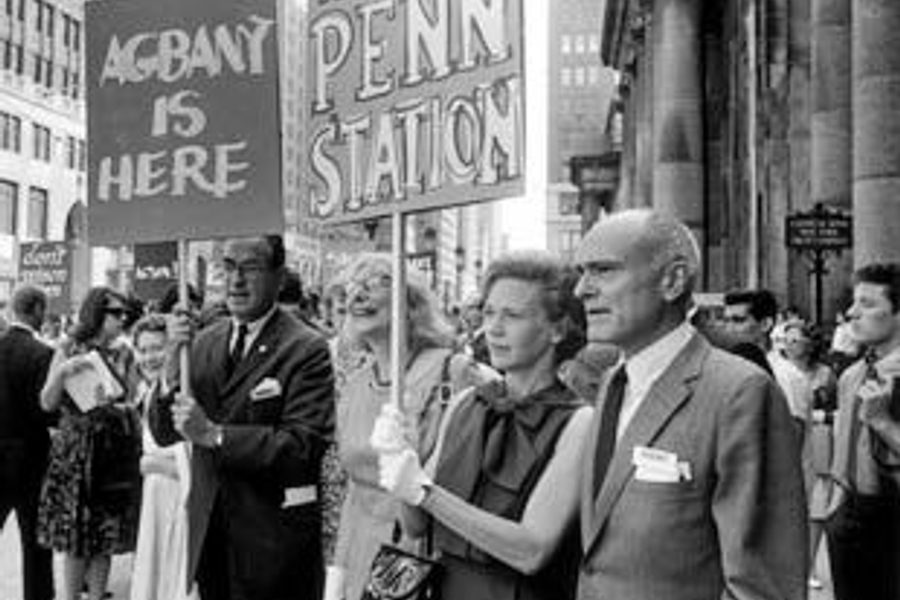
When Jane Jacobs died this past spring, the flood of obituaries carried with them a litany of praise. Jacobs, they said, had faced down the great, infamous builder Robert Moses, ended neighborhood-killing urban renewal policies, and transformed urban planning with her lyrical evocation of Greenwich Village’s “intricate sidewalk ballet” in The Death and Life of Great American Cities.
And yet, these sorts of tributes to a “legend” – while not undeserved – gloss over political and historical context, and drown questions of Jacobs’ larger significance for postwar history in a readymade bath of piety and awe. So it is welcome that, after a fitting period of mourning and tribute, the first book-length treatment of Jacobs’ life and work, Alice Sparberg Alexiou’s Jane Jacobs: Urban Visionary, should appear this summer.
Unfortunately, Alexiou’s book doesn’t quite deliver the goods. Denied direct access to Jacobs and her family and friends, Alexiou gamely circles around the edges of the thinker’s world, delivering a thorough account of Jacobs’ career and the response to her books and activism. Too often, however, she delivers abstract paeans to Jacobs’ thought that assume too much. “The eloquence of Jane Jacobs,” she writes in a typical passage, “affected our souls so viscerally that decision makers could not for long ignore the passions she had stirred up.” This feels less like a judgment than a received notion. Where Alexiou makes criticisms – Jacobs’ insufficient attention to race, for instance, or that her concept of “unslumming” was simply a bloodless term for the unsavory process of gentrification – they seem to be exercises in finger-wagging over Jacobs’ “silences” rather than efforts to understand what those gaps can tell us about Jacobs’ approach to her two great interlinked subjects: cities and economies.
Jacobs was born Jane Butzner in Scranton, Pa., in 1916, the third child of a nurse and a prominent doctor. From Scranton and her parents she inherited a potentially paradoxical combination of love for cities and belief in the supposedly “small town” virtues of independence and ingenuity. “I was brought up to believe,” Jacobs later wrote, “that simple conformity results in stagnation for a society, and that American progress has been largely owing to the opportunity for experimentation, the leeway given initiative, and to a gusto and freedom for chewing over odd ideas.” This echoed throughout her work; she consistently looked for the patterns of small town life lurking beneath the complexity of cities and maintained that economic growth was a function of ideas and ingenuity.
After high school Jacobs moved to New York. There, she discovered Greenwich Village, where she would live until she left the United States for Canada in 1968. After World War II, Jacobs took an editorial position at Architectural Forum, the tribune of modernist design and city planning owned by Time-Life. At Forum, she became increasingly disturbed by the modern “tower-in-the-park” city rebuilding schemes her bosses considered state-of the-art urban design. To her, they disregarded and even destroyed everything she valued about life in New York.
As Alexiou demonstrates, she really began to doubt the virtue of the new housing and renewal projects after she met William Kirk, the headworker at Union Settlement House in East Harlem. Kirk and his colleagues were seeing an unprecedented influx of public housing in their neighborhood. Huge slum clearance projects were displacing long-term residents and businesses, while new residents struggled to adapt to life in the austere modernist towers. She joined the Union Settlement Board and – although Alexiou does not mention it – contributed to the East Harlemites’ seminal (although largely forgotten) efforts to reform public housing design. Later, in Death and Life, she would credit Kirk with “the basic idea” that drove her book, that of “understanding the intricate social and economic order under the seeming disorder of cities.”
Meanwhile, Jacobs was developing a reputation as an iconoclastic urban thinker. Her editors – despite their difference of opinion – continued to support her, sending her to conferences and publishing her critiques. They even put up with her notoriety, which stemmed from her first foray into activism, a successful six-year battle fought alongside her neighbors to prevent Robert Moses from running a road through Washington Square Park. In 1958, after her article, “Downtown Is For People,” appeared in Fortune magazine, she secured a grant from the Rockefeller Foundation to turn her ideas into a book. Taking a leave from work, she retired to the Village to write.
More than two years later, as she was finishing Death and Life, Jacobs learned that the city was planning a renewal project for her neighborhood. Once again she joined her neighbors in the fight, helping to form the Committee to Save the West Village. For almost a year the Committee demonstrated, wrote letters, circulated petitions and packed meeting halls, finally getting the city to reverse its designation of the West Village as a slum in early 1962.
And yet, just as that struggle ended, a new one began. In 1962, Moses moved to build the Lower Manhattan Expressway. Starting at the Holland Tunnel, Lomex, as it was called, would have plowed through the lower part of the Village and cut a vast swath through Soho before slicing through Little Italy and Chinatown on its way to the Manhattan Bridge. By the time the successful six-year campaign to kill the expressway ended in early 1969, Jacobs had left the country altogether, driven to Toronto by her opposition to the Vietnam War and her dismay over her clashes with New York officials.
In Toronto, Jacobs continued both her activism and her writing, churning out eight more books between 1968 and 2004. As Alexiou shows, Canadians embraced Jacobs as an “urban guru.” Even as she faded into near-obscurity in the country of her birth, she remained an active contributor to public life in Canada until her death.
Unfortunately, Jacobs is more often referred to than read these days, so it’s a shame that Alexiou doesn’t give sustained attention to what she rightly calls Jacobs’ great “urban trilogy”: Death and Life, The Economy of Cities and Cities and the Wealth of Nations. She skims over the surface of these works – summing up their contents rather than delving into them – preferring to focus on illustrative case studies, reviews of the books and the reverberations they caused. She devotes the most attention to Death and Life, which is fitting, as it has become something of a minor classic.
Amongst urbanists, the book is often recalled for its four-part prescription for diverse, healthy city neighborhoods: districts with multiple functions, short blocks, buildings that vary in age and condition, and a sufficiently dense population. But the heart of the book, and the jumping off point for her later work on economics, is the lesson she had learned in East Harlem. Cities, she wrote, posed “a problem in handling organized complexity.” She found a natural order beneath the seeming chaos of cities, one that she likened to what Alexiou calls “delicate, teeming ecosystems.” For Jacobs, cities and economies alike are products of millions of individual decisions and ideas that combine in cooperation to form an “organic whole.”
Jacobs’ iconoclastic ideas raised questions about her political beliefs. Her opposition to the Vietnam War and her role in organizing movements for urban social justice seem to mark her as a woman of the left. And yet, conservatives also embraced Jacobs’ wars with City Hall, joining her on the barricades to stop federal urban renewal policy. They found comfort in her cantankerous individualism and her attack on planners and government bureaucracy. Her economic ideas – which locate the roots of productivity in ingenuity rather than class struggle – attract libertarians.
Of course, as Alexiou shows, Jacobs steadfastly rejected all political labels. Alexiou rightly suggests that we see Jacobs as a pragmatist. One of the joys of reading Jacobs is the improvisational way she recombines ideas from across the political map, using whichever seem to work at the time to help her understand a problem. But Jacobs was more than a pragmatist. She was perhaps the greatest proponent of a new, postwar political stance: the rebel against technocratic modernization.
Unfortunately, Jacobs’ conception of the way that complexity is squeezed out of cities and economies is somewhat one-dimensional. She can see coercion from outside, imposed on her organic systems, but rarely within them. Her neighborhoods and economies work by way of cooperation and parallel tasking, but not by way of power, conflict or exploitation.
Understanding the role of social divisions like race, gender, class and sexuality – whether in urban space or in economic development – requires believing in the importance of conflict, discrimination, inequality and struggle. Jacobs’ activism and ideas have endeared her to several generations of city lovers, both liberal and conservative. And yet her ideas find their limits in those hard realities that still bedevil more conventional thinkers on both the right and left.






